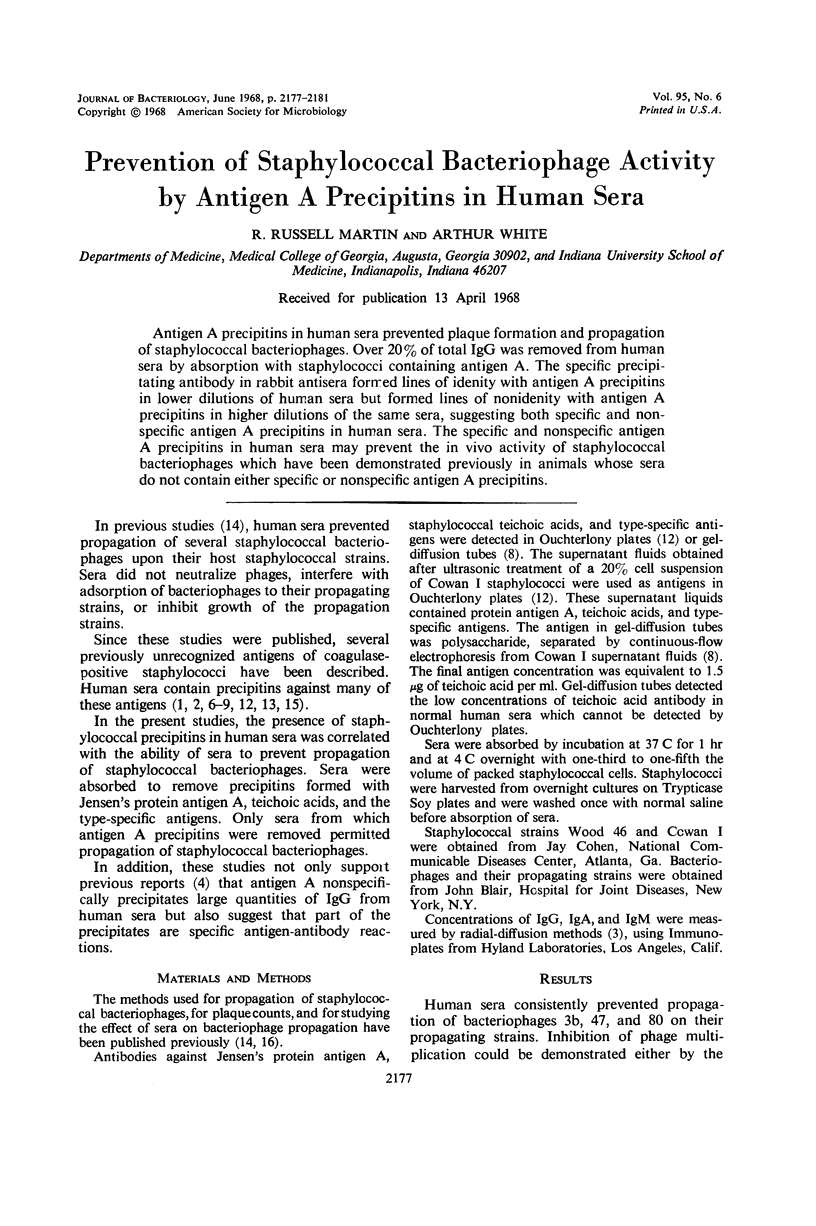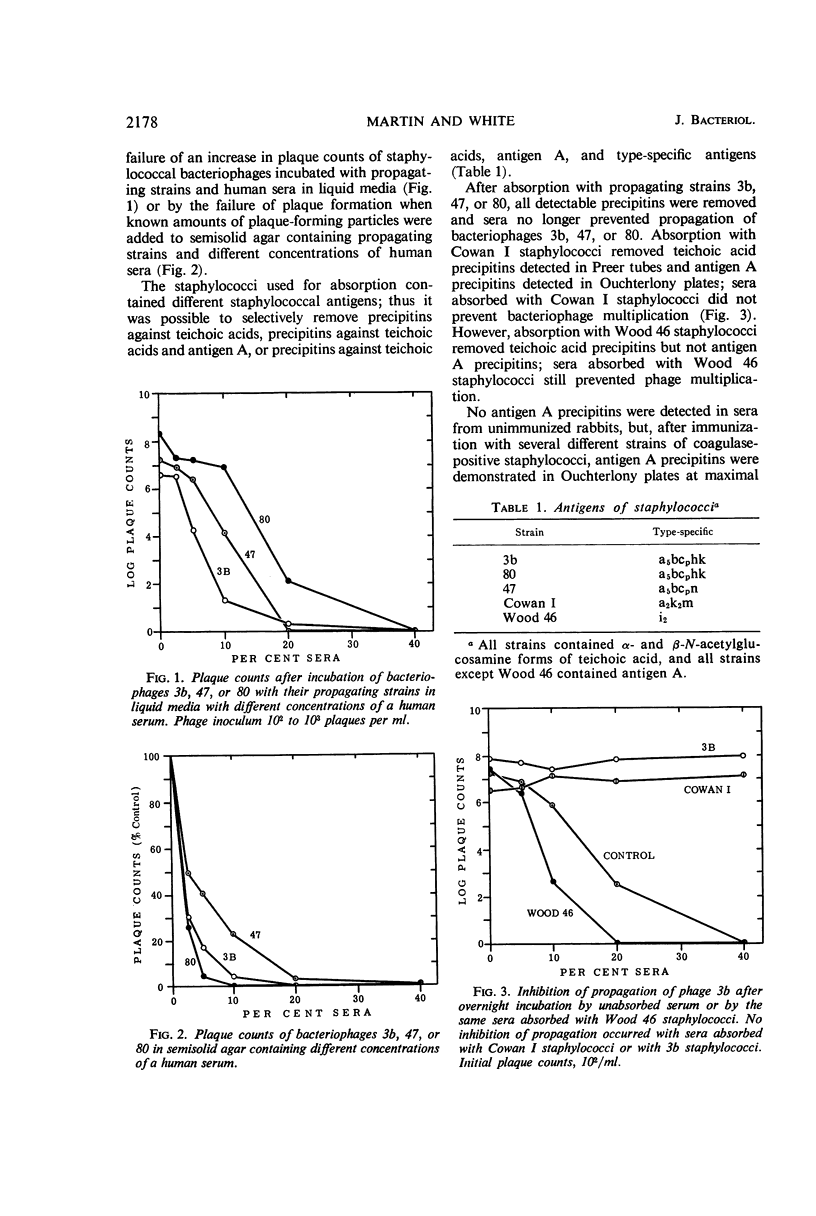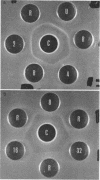Abstract
Antigen A precipitins in human sera prevented plaque formation and propagation of staphylococcal bacteriophages. Over 20% of total IgG was removed from human sera by absorption with staphylococci containing antigen A. The specific precipitating antibody in rabbit antisera formed lines of idenity with antigen A precipitins in lower dilutions of human sera but formed lines of nonidenity with antigen A precipitins in higher dilutions of the same sera, suggesting both specific and nonspecific antigen A precipitins in human sera. The specific and nonspecific antigen A precipitins in human sera may prevent the in vivo activity of staphylococcal bacteriophages which have been demonstrated previously in animals whose sera do not contain either specific or nonspecific antigen A precipitins.
Full text
PDF




Images in this article
Selected References
These references are in PubMed. This may not be the complete list of references from this article.
- Daugharty H., Martin R. R., White A. Antibodies against staphylococcal teichoic acids and type-specific antigens in man. J Immunol. 1967 Jun;98(6):1123–1129. [PubMed] [Google Scholar]
- Daugharty H., Shriver M., White A. Serological activity of staphylococcal polysaccharide. J Bacteriol. 1967 Jan;93(1):131–134. doi: 10.1128/jb.93.1.131-134.1967. [DOI] [PMC free article] [PubMed] [Google Scholar]
- FAHEY F. L., LAWRENCE M. E. QUANTITATIVE DETERMINATION OF 6.6 S GAMMA-GLOBULINS, BETA-2A-GLOBULINS AND GAMMA-1-MACROGLOBULINS IN HUMAN SERUM. J Immunol. 1963 Nov;91:597–603. [PubMed] [Google Scholar]
- Forsgren A., Sjöquist J. "Protein A" from S. aureus. I. Pseudo-immune reaction with human gamma-globulin. J Immunol. 1966 Dec;97(6):822–827. [PubMed] [Google Scholar]
- JAROLMEN H., BONDI A., CROWELL R. L. TRANSDUCTION OF STAPHYLOCOCCUS AUREUS TO TETRACYCLINE RESISTANCE IN VIVO. J Bacteriol. 1965 May;89:1286–1290. doi: 10.1128/jb.89.5.1286-1290.1965. [DOI] [PMC free article] [PubMed] [Google Scholar]
- MITSUHASHI S., OSHIMA H., KAWAHARADA U., HASHIMOTO H. DRUG RESISTANCE OF STAPHYLOCOCCI. I. TRANSDUCTION OF TETRACYCLINE RESISTANCE WITH PHAGE LYSATES OBTAINED FROM MULTIPLY RESISTANT STAPHYLOCOCCI. J Bacteriol. 1965 Apr;89:967–976. doi: 10.1128/jb.89.4.967-976.1965. [DOI] [PMC free article] [PubMed] [Google Scholar]
- Martin R. R., Crowder J. G., White A. Human reactions to staphylococcal antigens. A possible role of leukocyte lysosomal enzymes. J Immunol. 1967 Aug;99(2):269–275. [PubMed] [Google Scholar]
- Martin R. R., Daugharty H., White A. Staphylococcal antibodies and hypersensitivity to teichoic acids in man. Antimicrob Agents Chemother (Bethesda) 1965;5:91–96. [PubMed] [Google Scholar]
- Novick R. P., Morse S. I. In vivo transmission of drug resistance factors between strains of Staphylococcus aureus. J Exp Med. 1967 Jan 1;125(1):45–59. doi: 10.1084/jem.125.1.45. [DOI] [PMC free article] [PubMed] [Google Scholar]
- SINGLETON L., ROSS G. W., KOHN J. STAPHYLOCOCCAL TEICHOIC ACID ANTIBODY IN THE SERA OF PATIENTS WITH BURNS. Nature. 1964 Sep 12;203:1173–1174. doi: 10.1038/2031173a0. [DOI] [PubMed] [Google Scholar]
- Smith J., White A. EFFECT OF HUMAN SERA ON THE PROPAGATION OF STAPHYLOCOCCAL BACTERIOPHAGES. J Bacteriol. 1960 Dec;80(6):741–743. doi: 10.1128/jb.80.6.741-743.1960. [DOI] [PMC free article] [PubMed] [Google Scholar]
- TORII M., KABAT E. A., BEZER A. E. SEPARATION OF TEICHOIC ACID OF STAPHYLOCOCCUS AUREUS INTO TWO IMMUNOLOGICALLY DISTINCT SPECIFIC POLYSACCHARIDES WITH ALPHA- AND BETA-N-ACETYLGLUCOSAMINYL LINKAGES RESPECTIVELY. ANTIGENICITY OF THEICHOIC ACIDS IN MAN. J Exp Med. 1964 Jul 1;120:13–29. doi: 10.1084/jem.120.1.13. [DOI] [PMC free article] [PubMed] [Google Scholar]




